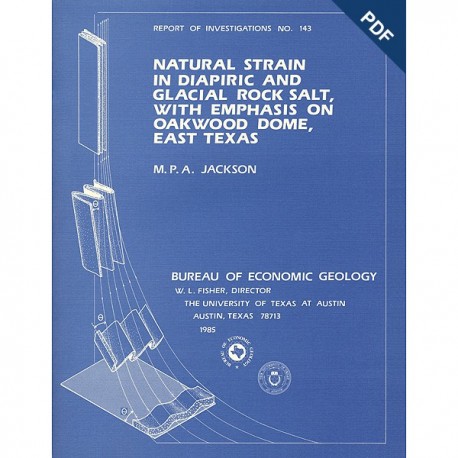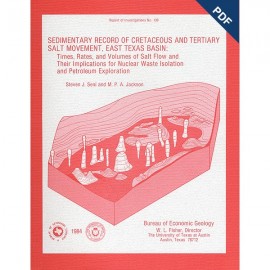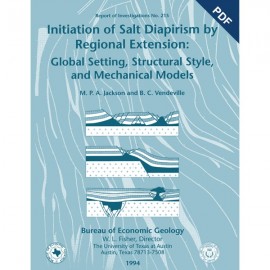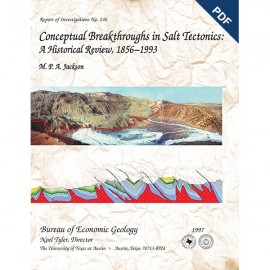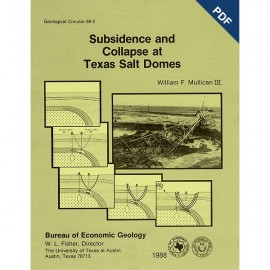Reports of Investigations
-
Books & Reports
- Reports of Investigations
- Guidebooks
- Udden Series
- Geological Circulars
- Down To Earth
- Atlases of Major Oil and Gas Reservoirs
- Texas Memorial Museum Publications
- Environmental Geologic Atlas of the Texas Coastal Zone
- Mineral Resource Circulars
- Other Reports
- Seminars and Workshops
- Handbooks
- Submerged Lands of Texas
- Symposia
- Annual Reports
- Open File Reports
-
Maps & Cross Sections
- Thematic Maps
- Miscellaneous Maps, Charts & Sections
- Geologic Atlas of Texas
- STATEMAP Project Maps
- Geologic Quadrangle Maps
- Cross Sections
- Highway Geology Map
- Energy and Mineral Resource Maps
- Shoreline Change and Other Posters
- Wilcox Group, East Texas, Geological / Hydrological Folios
- Bouguer Gravity Atlas of Texas
- River Basin Regional Studies
- Featured Maps
- Posters
- Teachers & the Public
-
Geological Society Publications
- Gulf Coast Association of Geological Societies
- Alabama Geological Society
- Austin Geological Society
- Corpus Christi Geological Society
- Houston Geological Society
- Lafayette Geological Society
- Mississippi Geological Society
- New Orleans Geological Society
- South Texas Geological Society
- GCS SEPM Publications
- Historic BEG & UT Series
Natural Strain in Diapiric and Glacial Rock Salt, with Emphasis on Oakwood Dome, East Texas. Digital Download
RI0143D
A free, digital version of this publication can be found on: Texas ScholarWorks
To purchase a print version (if available): RI0143
RI0143D. Natural Strain in Diapiric and Glacial Rock Salt, with Emphasis on Oakwood Dome, East Texas, by M. P. A. Jackson. 74 p., 46 figs., 5 tables, 1985. doi.org/10.23867/RI0143D. Downloadable PDF.
To purchase this publication in book format, please order RI0143.
ABSTRACT
Structural styles in the gravity-driven, ductile flow processes of glaciers and diapirs are analyzed. When dampened by rainfall, salt glaciers flow rapidly under minute differential stress. Thus, the concentration of water in diapiric rock salt is crucial to predicting creep rates in a repository medium. Natural-strain rates of rock salt range greatly from 10-8/s to 10-16/s; rates of average diapiric uplift are slowest. Contrary to widespread generalization, structural attitudes in dome salt mines are predominantly moderate to steep (60° to 80°) rather than vertical.
Diapiric folds may be triggered by (1) shear stresses induced by upward flow, (2) shear stresses induced by boundary effects of the salt source layer, and (3) normal stresses induced by convergent flow. Folding in salt stocks follows the similar-fold model, although some folds may have begun as buckles. Closed interference structures are sheath folds formed by intense constriction of originally gentle fold culminations and depressions. Construction of plunge-isogon maps from mapped linear structures allows the flow directions of diapiric salt to be deduced.
Geometric and strain analyses of salt core from Oakwood Dome show that the well bore penetrated the hinge zone and lower limb of an inclined, overturned antiform, which probably represents a salt tongue that has spread outward from the diapir center. Structural evidence indicates truncation of the diapir crest, probably by ground-water dissolution during cap-rock formation. The uppermost 2 m of rock salt recrystallized in the presence of water. Homologous temperatures and present maximum erosion rates suggest that the salt recrystallized at least 3 Ma ago at depths 400 m greater than present.
All the strains recorded in Oakwood halite are of the flattening type. The ratio of flattening to constriction increases upward, whereas strain intensity decreases upward. This strain pattern may represent a transition to an originally “neutral” zone in the diapir, since removed by dissolution. Orientations of maximum-extension axes in rock salt vary widely.
Keywords: diapirs, East Texas, fabric, finite-strain analysis, flow structures, folds, glaciers, salt domes, salt tectonics, shear zones, structural geology
CONTENTS
ABSTRACT
INTRODUCTION
PART I: GRAVITY-DRIVEN DEFORMATION: COMPARISON BETWEEN GLACIERS, NAMAKIERS, AND SALT DIAPIRS
Relevance of glaciers and namakiers to salt-diapir studies
Lithology
Mass balance
Morphology
Boundary conditions
Bulk-strain pattern
Fabrics
Flow mechanisms
Deformation temperatures
Strain rates and stresses in halokinesis and their relation to experimental deformation of rock salt
Ductile shear zones
Folded glacial moraines
Folds in namakiers
Folds in salt diapirs
Fold style
Mechanics of similar folding
Formation of folds and interference structures in salt stocks
Assessing large-scale flow patterns from linear elements
PART II: STRUCTURE OF THE TOG-1 SALT CORE, OAKWOOD DOME
Geometric analysis
Structural elements
Defining orientation in nonoriented core
Structural cross section
Implications for internal structure
Strain analysis
Two-dimensional strains
Three-dimensional strains
Significance of measured strains
Actual strains and measured strains
Model strains and measured strains
Recrystallization and measured strains
CONCLUSIONS
ACKNOWLEDGMENTS
REFERENCES
FIGURES
1. Map showing the East Texas Basin and location of Oakwood Dome
2. Flow properties of dry rock salt under varying conditions of temperature, strain rate, and differential stress
3. Homogeneous change in thickness by uniform simple shear parallel to x
4. Flow folds in the northern namakier of Kuh-e-Namak, Dashti Province, southern Iran
5. Low-temperature mylonite comprising porphyroclasts and highly strained streaks of competent, pale sandstone in an incompetent matrix of dark rock salt
6. Schematic evolution of loops in glacial medial moraines caused by differential ice flow in main trunk and two tributary ice streams
7. Fold patterns in medial moraines of the lower Susitna valley glacier, central Alaska
8. Folds defined by medial moraines in the Malaspina piedmont glacier, southeast Alaska
9. Map of the Bering piedmont glacier, southeast Alaska, showing movement vectors for surges from 1957 to 1963
10. Fold-shape analysis and classification of folds
11. Fold-shape analysis of large folds defined by disseminated-anhydrite layers in underground salt mines in Grand Saline Dome, East Texas, and Avery Island Dome, Louisiana
12. The appearance of ideal similar folds formed by differential simple shear of layers along parallel flow lines
13. Models of the formation of similar and subsimilar folds
14. Incremental bulk strains and superposed folding in three deformation zones in a mature diapir
15. Models for generating folds during centripetal flow of rock salt into a salt diapir
16. Rotation and axial constriction of initially open, upright, horizontal folds to form isoclinal, vertical folds by upward flow of salt into the trunk of a diapir
17. Refolding and rotation of originally recumbent F1 folds during flow of salt into and up the trunk of a diapir
18. The changing orientations of F1 and F2 folds during F2 refolding and rotation shown in figure 17
19. Model showing theformation of vertical and near-vertical F2 -F1 sheath folds during D2 deformation by intense constriction of folds during diapiric rise of rock salt
20. Cross sections through large fold-interference structures in the roofs of Gulf Coast salt-dome mines, illustrating six basic patterns
21. Maps showing inferred flow paths and flow directions of rock salt in three salt-dome mines
22. Maps showing plunge isogons for linear elements in rock salt in three salt-dome mines
23. Cross sections through salt domes showing major structure and inferred salt tongues based on plunge isogons in figure 22
24. Model showing the homogeneous rise of material by differential advance
25. Equal-area stereographic projection showing conventions for describing orientation of structural elements in the TOG-1 core
26. Structural cross section along vertical salt core, Oakwood Dome, and transecting schistosity in the halite
27. Deducing the orientation of a fold axis from the trace of layering in a schistosity plane
28. Medium-scale hypothetical structures within Oakwood Dome
29. One model showing flow patterns within Oakwood Dome
30. Model deformation fabrics produced by homogeneous, plane-strain, pure shear of ideal populations of circular and elliptical particles
31. Unstrained elliptical particles, numbered arbitrarily for reference, and a unit circle, showing initial axial ratios and (Ø angles)
32. The particles of figure 31 after homogeneous pure shear showing finite axial ratios and Ø angles
33. Comparison of strain-analysis methods applied to core from Oakwood Dome, showing minimum strain and maximum strain
34. Strain states in rock-salt specimens 1166, 1178, 1233, and 1275 on RtØ plots
35. Strain states in rock-salt specimens 1305, 1315, 1337, and 1339 on RtØ plots
36. Strain states in rock-salt specimens 1166, 1178, 1233, and 1275 on the shape-factor grid
37. Strain states in rock-salt specimens 1305, 1315, 1337, and 1339 on the shape-factor grid
38. Error-analysis histograms of strain data of 2,400 grains in the eight rock-salt specimens
39. Theoretical fabrics produced by homogeneous strains of a model sample of elliptical particles on the shape-factor grid
40. Flinn diagram showing the mean strain in the all-grains samples of halite recorded by all three methods of strain analysis
41. Flinn diagram showing triangles of discrepancy between results obtained by different methods of strain analysis on the same specimen
42. Hsu diagram showing strain states in the three different grain-size populations: all grains, large grains, and small grains
43. Variations in strain magnitude and type with depth
44. Equal-angle stereographic projection of the orientations of the principal axes of strain (X, Y, and Z)
45. Schematic illustration of a model for accretion of anhydrite cap rock, formation and closure of a dissolution cavity, and superimposed strains in Oakwood Dome
46. Quantitative modeling of superimposed strains in the crest of Oakwood Dome
TABLES
1. Natural-strain rates in the deformation of rock salt
2. Some methods of strain analysis applied to elliptical particles
3. Two-dimensional strain ratios from Oakwood Dome salt core obtained by three different methods
4. Three-dimensional strain parameters from Oakwood Dome salt core obtained by three different methods
5. Probable physical conditions existing during Oakwood Dome diapirism
Citation
Jackson, M. P. A., 1985, Natural Strain in Diapiric and Glacial Rock Salt, with Emphasis on Oakwood Dome, East Texas: The University of Texas at Austin, Bureau of Economic Geology, Report of Investigations No. 143, 74 p.
